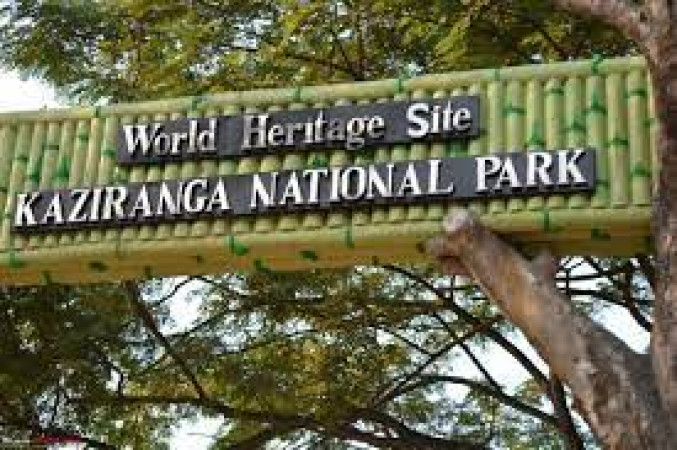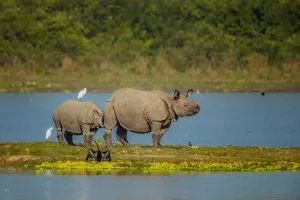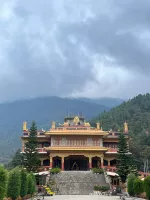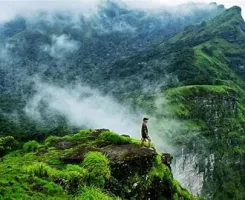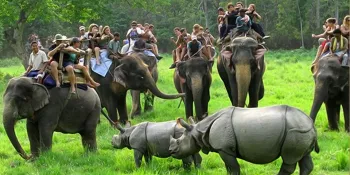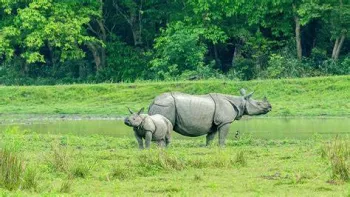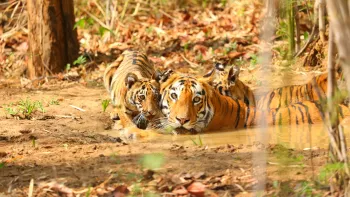Kaziranga National Park Travel Guide
Kaziranga National Park is a UNESCO World Heritage Site located in the northeastern state of Assam, India. Known for its vast expanse of tall elephant grass, marshland, and dense tropical forests, Kaziranga is home to the world's largest population of Indian one-horned rhinoceroses. The park also boasts a rich diversity of wildlife, including tigers, elephants, and various bird species. Its unique landscape and conservation efforts make it a must-visit destination for nature lovers and wildlife enthusiasts alike.Top Attractions in Kaziranga National Park
- Elephant Safari
- Jeep Safari
- Bird Watching at Sohola Beel
- Visit to the Orchid Park
- Exploring the Tea Gardens
Kaziranga National Park is Famous for
Its large population of Indian one-horned rhinoceroses.Top Attractions in Kaziranga National Park
- Experience thrilling wildlife safaris
- Witness the breathtaking beauty of the Brahmaputra River
- Explore the lush green forests and grasslands
- Engage in birdwatching and spot various migratory birds
- Interact with the local tribal communities
What's Great about Travelling to Kaziranga National Park?
- Opportunity to witness endangered wildlife species up close
- Immersive experiences in nature and wildlife conservation
- Perfect destination for photography enthusiasts
What's Not So Great about Travelling to Kaziranga National Park?
- Limited accommodation options within the park
- Remote location may require long travel hours
- Weather conditions can be extreme during certain months
Travel Tips for Kaziranga National Park
- Obtain necessary permits and follow park regulations
- Book safari experiences in advance to avoid last-minute disappointments
- Respect the wildlife and maintain a safe distance during encounters
Important Kaziranga National Park trip information
- Ideal Duration: 2-3 days
- Best Time to Visit: November to April
- Nearby Airports and Railway Stations: The nearest airport is in Guwahati, approximately 200 km away. The nearest railway station is in Furkating, about 75 km from the park.
Per Person
24,400
*EXCLUDING APPLICABLE TAXES Per Person
40,000
*EXCLUDING APPLICABLE TAXES Per Person
34,990
*EXCLUDING APPLICABLE TAXES Per Person
19,000
*EXCLUDING APPLICABLE TAXES 5.0 Ratings
( 8 Reviews )
( 8 Reviews )
Per Person
40,000
*EXCLUDING APPLICABLE TAXES Per Person
18,000
*EXCLUDING APPLICABLE TAXES FAQ's on Kaziranga National Park
Q1: What is the best time to visit Kaziranga National Park?
The best time to visit Kaziranga National Park is from November to April when the weather is pleasant, and wildlife sightings are at their peak. This period also coincides with the park's opening season, offering a higher chance to spot the famous one-horned rhinoceros and other wildlife. However, it is essential to note that the park is closed during the monsoon season from May to October due to heavy rains and flooding.
Q2: Do I need a visa to travel to Kaziranga National Park?
As Kaziranga National Park is located in India, visitors from most countries will require a tourist visa to enter. It is advisable to check with the Indian embassy or consulate in your country for specific visa requirements and application procedures. Some nationalities may be eligible for an e-visa or visa on arrival, but it is crucial to confirm this before traveling.
Q3: What are the must-visit attractions in Kaziranga National Park?
Kaziranga National Park is renowned for its wildlife and natural beauty. The must-visit attractions include Jeep safaris to spot the one-horned rhinoceros, Bengal tigers, elephants, and various bird species. The park also offers elephant safaris for a unique wildlife viewing experience. Additionally, a visit to the nearby Panbari Reserve Forest and the Kaziranga Orchid and Biodiversity Park are recommended for nature enthusiasts.
Q4: Is Kaziranga National Park a safe place to travel?
Kaziranga National Park is generally safe for tourists. However, visitors are advised to follow the guidelines provided by park authorities, especially during safaris and while exploring the park. It is essential to stay on designated paths, avoid approaching wild animals closely, and listen to instructions from guides. Travelers should also be cautious of wildlife crossings on the roads surrounding the park.
Q5: What is the local currency in Kaziranga National Park and can I use credit cards?
The local currency in Kaziranga National Park, as in the rest of India, is the Indian Rupee (INR). While credit cards are accepted at some hotels, restaurants, and larger establishments in the nearby towns, it is advisable to carry sufficient cash for smaller purchases and transactions. ATMs are available in the surrounding areas for convenient access to cash.
Q6: What is the local cuisine like in Kaziranga National Park?
The local cuisine in Kaziranga National Park offers a blend of Assamese, Indian, and tribal flavors. Must-try dishes include Assamese thali, fish preparations like Masor Tenga, and traditional sweets like Pitha. Vegetarian options like Khar, Aloo Pitika, and various rice dishes are also popular. Travelers with dietary restrictions can find options like fresh fruits, vegetables, and international cuisine in the restaurants near the park.
Q7: What transportation options are available in Kaziranga National Park?
Transportation options in Kaziranga National Park include hiring local taxis, auto-rickshaws, and organized tours for exploring the park and surrounding areas. Public buses and shared jeeps are available for travel between nearby towns and cities. Rental cars and motorcycles are also options for more independent travel. For wildlife safaris within the park, guided tours in designated vehicles are the recommended mode of transportation.
Q8: Are there any cultural norms or etiquette I should be aware of when visiting Kaziranga National Park?
When visiting Kaziranga National Park, it is essential to respect local customs and traditions. Wearing modest clothing that covers shoulders and knees is recommended, especially when visiting religious sites or interacting with local communities. It is customary to greet locals with a polite "Namaste" and seek permission before taking photographs, especially of individuals. Avoiding public displays of affection and being mindful of wildlife and nature conservation are also important aspects of responsible tourism in the region.
Q9: I am a travel agent. How can I buy travel leads of Kaziranga National Park?
Register yourself as a travel agent at agents.tripclap.com and then you can buy travel leads to Kaziranga National Park once your account is approved. For more details contact our support team at +91-8069186564 or support@tripclap.com
